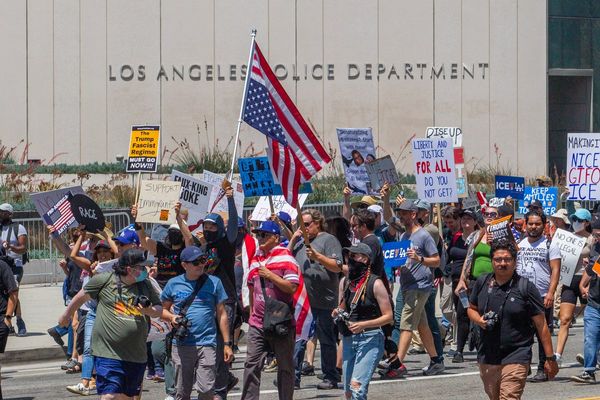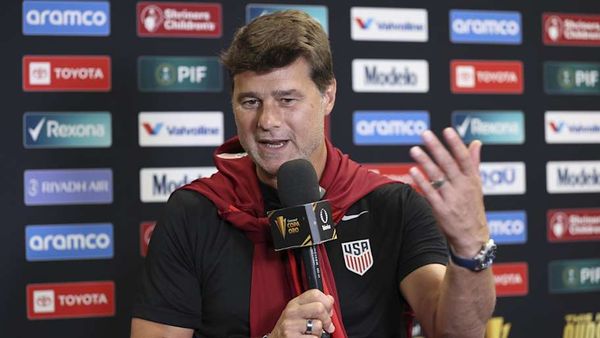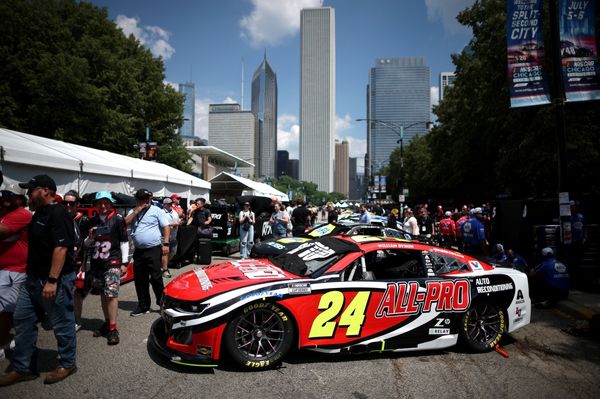DETROIT — It was autumn 1979 when Sam Raimi, Bruce Campbell and a small group of Detroit friends headed off to the woods in Tennessee to make a horror movie.
Two years later, their low-budget, high-splatter romp “The Evil Dead” changed their lives forever and won a cult of fans that is still growing today.
But it didn't come easy. The cast and crew endured a hellish shoot that could almost be described as cursed. Filming dragged on for months as actors and crew members suffered scrapes, bruises, cuts, broken bones and worse. “No one got off easy. No one," says Campbell. "The shoot sucked, but we just didn't know any better."
Ahead of the 40th anniversary of the film's premiere on Oct. 15, 1981, this is the story of how it came to be, the ways it affected its cast members, and how all these years later "The Evil Dead" continues to find new life.
The Super 8 kids
Campbell and Raimi met in middle school at West Maple Junior High in Birmingham. Campbell remembers vividly the first time he saw the young Raimi, dressed as Sherlock Holmes, sitting on the floor of the hallway, playing with dolls. “I remember very specifically going, 'I'm walking waaay around that guy,'” says Campbell, on the phone recently from his home in Los Angeles. “I remember thinking, ‘where was he created?’”
It wasn’t long before common interests brought them together. Campbell was taking typing, which he found no use for — to this day, he says he still hunts and pecks — and he went to his guidance counselor and dropped the course in favor of a radio broadcasting class. That’s where he and Raimi officially met and quickly hit it off.
They both had a love of cinema and made movies on Super 8 cameras in their respective neighborhoods. Along with Scott Spiegel, another classmate, they combined forces and equipment and spent their time together after school and on weekends starring in their own slapstick comedies.
“We were all big Three Stooges fanatics, so everything had a Three Stooges bend to it,” says Campbell.
Campbell’s father, who worked in the ad industry in Detroit, was a member of a local theater troupe, and Campbell had keys to the theater, giving him access to a cache of costumes. Campbell worked at a local grocery store, and he was allowed to take home pies, potato salad and egg salad that were past their expiration dates, all of which were used as props in their movies, which often revolved around silly stunts and jokes of which Campbell was the butt.
“It was really our way of staying out of trouble,” says Campbell, now 63. “I swear to God we didn't get in any legitimate trouble, like with drugs or alcohol or women, because we were too busy making these dumb movies.”
They also participated in high school theater productions at Groves High School, which is where they met Ellen Sandweiss, a classmate who was also acting in school plays. Soon Sandweiss was appearing in the group's Super 8 movies as well.
“They got girls to be in their movies when they needed one, but we were never part of the moviemaking group,” says Sandweiss, on the phone from her home in Asheville, North Carolina. “That was definitely the boys, and they had their own boys club.”
That boys club continued to make movies throughout high school but had their doubts about filmmaking as a legitimate career path. “We only whispered to ourselves that this was something we wanted to do for a living,” Campbell says. “But after high school, it forced the issue.”
Raimi went off to Michigan State University and Campbell to Western Michigan, although he wasn't long for Kalamazoo. Campbell came home or went to State every weekend to make movies with his pals, and after getting a job working as a production assistant on commercials in Detroit, he dropped out of school within six months.
Raimi, meanwhile, continued making short films and honing his craft. One short, titled “The Happy Valley Kid,” centered on a bullied student who exacts revenge on those who had done him wrong. It was made for $700, and through on-campus screenings, it grossed $5,600, a huge success for a homespun production.
Raimi followed with “It’s Murder,” a full-length movie shot on Super 8, which starred Campbell and carried a $2,000 budget, triple that of “The Happy Valley Kid.” It wound up bombing. Campbell remembers one screening where there was only paying customer, and that theatergoer got up and walked out halfway through. Though there was no one in the theater, the film still had to play all the way through so it could be placed back on its reel.
“That was a very lonely couple of minutes in the theater,” says Campbell. “But it gave us a taste of failure early on.”
From comedy to horror
While their hearts were in comedy, the goofier the better, for filmmakers just starting out in the late 1970s it was difficult to find financing for a comedy, Campbell says.
“We were very concerned that if we were going to actually take money from real investors to make a movie, for the actual marketplace, it had it had to be something that could make money,” Campbell says. “With comedy at that time, you needed Steve Martin or John Candy in it, otherwise, no one would talk to you. But you could always make a low-budget horror movie.”
Movies like “Halloween,” “The Hills Have Eyes” and “The Texas Chainsaw Massacre” didn’t have stars, elaborate sets, fancy costumes or exotic locations, and they were gritty rather than glossy. “So horror was our way out,” Campbell says. “But we weren’t going to skimp on it. The horror was going to be really horrifying.”
Campbell, Raimi and Robert Tapert, a roommate of Raimi's brother Ivan, attended drive-in showings of horror movies such as “Revenge of the Cheerleaders” and “Massacre at Central High,” studying what worked and what didn’t and how audiences reacted to certain scenes. It wasn't so much a night out at the movies as it was market research.
“They'd flash their lights or honk the horn if they didn't like something,” Campbell says. “‘Then 'Texas Chainsaw Massacre’ shut everybody up. We went to a screening of that and nobody honked, nobody flashed their lights, and you couldn't hear a word because everyone was so terrified. And we're like, this is what you do. Once the horror starts, you never let up.”
They began seeking investors, starting with family. Campbell’s parents were the first to chip in, cutting a $10,000 check, and other family members, associates and entrepreneurs coughed up $10,000 checks as well.
To get the ball rolling, Raimi and Campbell, along with actress Sandweiss, made a 30-minute short film, “Within the Woods,” to show to investors. Eventually, they secured $85,000 in financing and set off to shoot in the woods in Tennessee, which wound up being the first of many follies. They went down South because they figured the weather would be warmer there than in Michigan. Not so much. “Tennessee had one of the coldest winters on record,” Campbell says. “And Detroit, I think, actually had a mild winter.”
But it didn’t matter, they were making a movie.
“This was exciting as hell,” Campbell says. “We didn't have any sense to know that we were doomed.”
Lights, camera, action
Shooting started in November 1979 in Morristown, Tennessee, about an hour northeast of Knoxville. Fueled by Moon Pies and Mello Yello, the cast and crew got to work on the tale of a group of college students who set off for a weekend at a cabin in the woods and wind up awakening the spirits of the dead, which possess and attack them one by one. Campbell stars as Ashley “Ash” Williams, alongside Sandweiss, Betsy Baker, Theresa Tilly and Richard DeManicor.
Having never made a real movie before, no one really knew what they were doing. Twelve-hour days would result in one or two completed shots. The cabin where most of the filming took place was cold and uninsulated. The cast and crew slept in a nearby cabin, rented out for the shoot; men slept in one bedroom, women in the other. The oldest person on set was all of 26 years old, and he was asked to make food for everyone. Turns out he didn't know how to cook.
“The good news is that we were very young,” says Sandweiss, who took a semester off from the University of Michigan to make the movie. “I was 20 when we started shooting, and I turned 21 while we were shooting. None of us had ever been on a feature film, so we knew it was kind of difficult, but we didn't really know, because we didn't have anything to compare it to.”
On-set injuries became commonplace. Campbell’s brother Don, a production assistant on the set, took a tumble from a cliff and hurt himself. Raimi got hit by a falling log. A crew member jumped from the rafters of the cabin and landed on a two-by-four with a nail sticking out, which went right through his foot. Campbell broke his ankle and was covered in cuts and scratches. And Sandweiss knocked herself out cold while filming a sequence where she had to jump backward through a hole in the floor.
“I'm fighting with Bruce, and he kicks me in the face, and I'm supposed to fall backwards into the cellar hole, which was which was just a hole they dug in the floor with a couple people underneath with a blanket to catch me when I fall,” says Sandweiss, who like the other actors in the film, was paid $100 a week for her work. “So I had to do it blind. He was kicking me, I was facing him, and I had to fling myself backwards and fall into a hole that was maybe 4 feet by 4 feet. So on one of those takes, I kind of missed the hole and just smacked the hell out of my head on the edge of the floor, 'cause I didn't know where I was going. I probably got a concussion, I don't know.”
“There was nothing sexy about the shoot at all,” Campbell says. “Everyone looked tired and everyone was tired. It certainly made you realize what you were made out of. It was not for everybody.”
But it wasn’t all misery. Raimi’s signature camera techniques are apparent from the beginning, and he employed innovative strategies and movie magic to get the shots he wanted.
In one scene, Sandweiss’ character, Cheryl, is possessed and begins floating inside the cabin, and Raimi wanted to achieve the effect without using strings or wires. So he filmed her against a window — in the scene it’s nighttime outside, so he blacked out the window with a dark cloth — and he used a teeter-totter rig that he built which extended outdoors, and had a crew member on the other side, moving her up and down. (Since it was Sandweiss on the contraption, it was dubbed the “Ellie-vator.”)
There was camaraderie among the cast and crew, and people wore multiple hats while shooting. When Campbell wasn’t acting in a scene, he would assist with lighting or run “fog dog” duty, shooting a fog machine in the background. Fire effects were achieved by dumping moonshine on a campfire.
Shooting stretched until January, at which point Sandweiss had to return to college. Other actors and crew members were forced to abandon ship due to timing issues as well. But Raimi, Campbell and Tapert soldiered on.
“There was no way we were gonna quit,” Campbell says. “We were discouraged, but mostly we were terrified to lose money. We knew that if we lost the investors’ money, we would never make another movie, at least in Detroit, because people have a long memory when they lose money. So we were motivated by that, and we would not get off that mountain without a movie. We came back broken, and we didn’t really have a plan. But it just allowed us to get our ships back in order again.”
After January, Raimi cut together a trailer from what he had filmed to show to investors to raise more money. Shooting eventually resumed, this time in various locations in Michigan, with local actors donning the same costumes like the other actors and crew members filling in wherever they were needed.
When filming was finally completed — Campbell jokes they had more shooting days than "Back to the Future" — Campbell asked his father if he could secure a loan against the family’s property near Gladwin, which would allow them to get the money needed to blow the film up from 16mm to 35mm, an essential step in the post-production process. Campbell's father agreed.
Raimi and Campbell took their footage to New York to edit it, work on sound and other finishing touches, living in a small apartment in the city while they worked through the process.
They were on their way, but an official release was still a long way off.
A new title
Before securing a distributor, the filmmakers threw themselves a local premiere at the Redford Theatre in October 1981, renting out the theater and inviting cast and crew and family out for a celebration of their hard work. The guys wore tuxedos and the women wore prom dresses. It was glitz and glamour, Detroit-style.
“It was a pretty good size crowd, around 400 or 500 people,” says the Redford Theatre’s John Lauter, who was there the night of the premiere. (Campbell, who never lets the truth get in the way of a good story, says it was more like 1,100 people.)
“It was really fun to watch it with a crowd,” Lauter says. “To us, it seemed like a better-than-amateur film that was quirky as hell that really fit the genre. But there was no sense that entirely new ground was breaking, or that a new genius was being discovered. It was more like, ‘well, that went good.’”
It didn’t go so well for everybody in the crowd. Sandweiss, who was seeing the finished film for the first time (and was seated in the theater next to her mother), was mortified by a scene where she is sexually penetrated by a tree.
“The script, if you can call it that, basically said for that scene, ‘Cheryl gets attacked by the woods.’ And I went, 'OK, everybody is getting attacked somehow in this movie, so yeah, let's go attack me in the woods.' And it didn't say anything about there being any kind of sexual nature to it, at all,” she says.
While filming the scene, “I started getting a little uncomfortable,” she says, but she was assured nothing graphic would be shown, and everything would be shown in long shots. “If it had really been something that I felt was overtly sexual in nature, then I wouldn't have done it.”
Cut to that night at the premiere, and during the scene in question, “I had no idea that it was going to look like that at all,” she says. “I wanted to crawl under my seat, but I did not leave the theater. And I have to hand it to my parents, they were very nonjudgmental about it. They didn't say a word. And it never came up again.”
After the premiere at the Redford, Campbell and Raimi were looking to secure a distributor when they met Irvin Shapiro, a producer who had worked on George A. Romero’s films and had done publicity for films such as “The Battleship Potemkin” and “The Grand Illusion.”
Shapiro, who was in his mid-70s at the time, watched the movie and saw potential. “He goes, ‘Well, it's not exactly ‘Gone with the Wind,’ but I think we can make some money with it,’” Campbell says, imitating Shapiro's crackly voice.
Shapiro, one of the founders of the Cannes Film Festival, helped get the movie into Cannes, where it screened outside of competition. He also fronted the $35,000 it would take to secure “delivery elements,” such as black-and-white and color publicity shots, prints of the movie without title screens that could be shown in foreign markets, a print of the movie without sound so foreign languages could be dubbed in, and more. But first, he required one major change.
At the time, through production and including at that Redford premiere, the film was titled “The Book of the Dead.” For Shapiro, that didn't fly.
“He said, ‘you're gonna have to change the title,’” Campbell says. “Because the original title was ‘Book of the Dead,’ he said people are gonna think they’ve got to read for 90 minutes. So he goes, ‘come up with some other names.’
"So we came up with, like, ‘Blood Flood,’ ‘101% Dead,’ really silly titles, and Irving goes, ‘why don't we just call it ‘Evil Dead?’ And we were like, ‘that's the worst title I've ever heard in my life.’ We thought it was bad," Campbell says. "He goes, ‘we're gonna call it ‘Evil Dead.’ It cuts to the chase: there's evil people and there's dead people.' He gave us the harsh reality of sales. He couldn’t sell ‘Book of the Dead,’ but he could sell ‘Evil Dead.’”
When “The Evil Dead” screened at Cannes, Stephen King was in the audience, and the master of horror came out raving. Prior to King, the film had received fair-to-middling reviews. King was much more enthusiastic, calling it “the most ferociously original horror film of the year.”
That quote, which was, in turn, slapped on the film’s posters, gave the movie the momentum it needed. A distribution deal was struck with New Line Cinema and the film received a release in the U.K. and in the United States, where it made around $3 million during its box office run.
"When I saw it at my local Showcase Cinema, where I had watched all the Hollywood movies growing up as a kid, that's when I knew we made it," says Campbell. "I didn't give a (expletive) about anything after that."
"The Evil Dead" landed on VHS in 1983 and was one of the first round of titles released just as the home video rental market began to take off, and it eventually became a cult hit over the course of multiple VHS and DVD releases.
The rest is a blood flood of history.
A legacy that won't die
“The Evil Dead” wound up launching a franchise that is still going today. “Evil Dead 2” — essentially a remake of “The Evil Dead,” but with the slapstick Three Stooges elements of Raimi and Campbell’s early Super 8 films thrown in for good measure — followed in 1987, and “Army of Darkness,” an all-out adventure-comedy following Campbell’s Ash character, finished the original trilogy in 1992.
A remake-slash-continuation titled “Evil Dead” followed in 2013, while “Ash vs Evil Dead,” a TV show based on the movie and starring Campbell, ran on Starz for three seasons between 2015 and 2018. There are “Evil Dead” comic books, video games and even a musical, and “Evil Dead Rise,” a new movie in the series — produced by Campbell and Raimi — is currently filming in New Zealand and is due out in 2022.
"The Evil Dead" turned Campbell into a cult icon as well as a bestselling author; his autobiography, "If Chins Could Kill: Confessions of a B Movie Actor" was released in 2001. Raimi went on to become one of Hollywood’s top directors, helming more than a dozen movies, including the original "Spider-Man" trilogy, as well as next year's Marvel entry "Doctor Strange in the Multiverse of Madness." In addition, Joel Coen of the Coen brothers was an assistant editor on the film, earning him one of his first screen credits, three years prior to the release of "Blood Simple."
With "The Evil Dead" marking its 40th anniversary, Campbell says the film's initial investors have made back their money many, many, many times over.
“Now we're paying off sons and grandchildren,” Campbell says.
Brett Pierce, one half of the filmmaking duo the Pierce Brothers, whose Michigan-made horror film "The Wretched" spent six weeks at No. 1 at the box office last year, was only a child when "The Evil Dead" set up shop to film in the cellar of his parents' Detroit home. Pierce's father, Bart, was a part of the movie's special effects team, and wandering into the basement one day, the young Pierce saw a special effects test that for years made him afraid of basements and gave him an unnatural fear of horror movies. "I thought they were going to melt my brain," he says.
He didn't know it then, but the experience actually influenced him to pursue filmmaking, specifically in the horror genre. "It put us on this path of just being obsessed with trying to scare people," Pierce says. "It affected us 100%. Because we watched dad do it, we watched Bruce and Sam do it, it made us naive enough to believe that we could make full-on movies. You just get all your scrappy friends, you all pull together, and that's how it gets done. You want to make a movie? You just go do it."
Sandweiss shied away from “The Evil Dead” for a long time after that fateful premiere but eventually came around, and says years later she wound up receiving an apology from Raimi for the way he handled that scene, which wound up branding the film with an NC-17 rating. After attending a 20th-anniversary screening at the Main Art Theatre in Royal Oak, Sandweiss started appearing at comic conventions along with her co-stars Baker and Tilly, who branded themselves as “Ladies of ‘The Evil Dead.’”
It was through going to the conventions that Sandweiss learned what a huge following there was for the film and the impact the movie had on fans.
"It was surreal because at the time, the three of us, we all had young kids, and so it was like we would go from our lives as suburban soccer moms to these conventions where all these very, very strange people were, with costumes and blood all over them. And I would sign people’s tattoos of my face, and it was this crazy kind of dual existence," she says. "I probably have 20 pictures of the tattooed Cheryl face on people’s body parts.”
Sandweiss says the film endures for a number of reasons.
“I think it's because it was so over the top,” she says. “Everything about it is so extreme. And also people who know cinematography and know films, you recognize a lot of the really innovative techniques that Sam used and the really creative ways of doing special effects with no money.
“And I also think there's a huge aspect of it’s so bad it’s good," she says. "I mean the movie, to me, is hysterical; I find it difficult to believe that people actually think it’s scary, because you see, like, when somebody is cutting off somebody’s hand, you see the rubber hand, and you see the fingers jiggling. And you see the moon in the sky, and it's so obviously fake. So I think you can like it as a good horror film, you can like it as a piece of kitsch, you can like it because it was innovative and low budget and all young people made it, and you can like it because it was so bad.”
Campbell remains immensely proud of the film, even the scene where you can clearly see a garden hose spewing out goo.
“All the foibles, they’re a part of the charm,” says Campbell. “I think people find it endearing as well. We were the little guys. We were not an indie darling, we were not a blockbuster, there was no huge box office, and there were no stars whatsoever.
"It’s a story that has stuck with us," he says. "It was a very indelible experience, good and bad, but it got us into the movie business. I have nothing but gratitude for this movie. I don’t care if people associate me with it forever. The movie was good to me, and it was good to all my buddies, and a lot of us are still working today.”
Asked if he thinks “Evil Dead” will ever die, Campbell lets out a hearty laugh.
“Let’s hope not,” he says.
———







